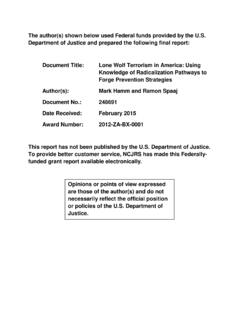Transcription of Defining Management and Organization - SAGE Pub
1 1 . Defining Management and Organization Learning Objectives Upon completion of this chapter, students should be able to do the following: Define Management , Organization , and leadership List and discuss criminal justice organizations and the various specialties in criminal justice Describe nonprofit and for-profit agencies I n this era of globalization accompanied by complexity, ambiguity, rapid change, and diversity, managing an Organization is a difficult task. Yet, good Management is criti- cal for the survival of an Organization . In fact, good Management is so important that Hanson (1986) found that a manager's ability to manage is 3 times stronger in explain- ing firm profitability than all other factors combined. Managers are challenged with making decisions, formulating goals, creating a mission, enacting policies and proce- dures, and uniting individuals in the Organization so that completion of all of these and other related tasks can be accomplished.
2 Despite the fact that Management pervades everything that an Organization does, who the Management actually is, is not always clearly defined. Management consists of many individuals in an Organization at varying levels and ranks, often classified as lower Management , middle Management , and upper Management . Hecht asserts that, many a person who carries the title of manager is not really a manager (1980, p. 1). People on the frontline may make decisions, formulate 1. 2 ADMINISTRATION AND Management IN CRIMINAL JUSTICE. procedures, and have input into the mission and long-term goals of the Organization . Does this make them Management ? Individuals employed in positions considered to be at the second or third level may also have input or titles that indicate they are managers within the Organization . Of course, people are familiar with the terms chief executive offi- cer, director, president, chief operating officer, and so on.
3 These are automatically assumed to be titles that indicate the ranks of Management . But is this an obvious assumption? According to Hecht (1980), Management is an activity and managers are charged with a number of people working at the task of getting some activity accomplished within a set period of time (p. 1). Research Defining Management has been ongoing and, to date, there is still not a clear definition of Management for all organizations. This chapter will investigate the definition of Management as well as tasks com- monly associated with managing an Organization . The term Organization will be defined and key aspects of organizational structures in nonprofit and for-profit agen- cies will be discussed. Leadership and how leaders work within organizations are dis- cussed as well. As this book pertains to Management in criminal justice, a brief summary of criminal justice agencies and their Management structures is also pro- vided to the reader.
4 Each chapter in the text this one included ends with a fictional case study and summary discussion. The case studies provide scenarios likely encoun- tered in real life. Although the case studies may resemble reality, they are based on fic- titious names, places, and occurrences. There are questions at the end of each case. There are no right or wrong answers to these questions. Instead, the intent is to allow for application and processing of the information learned in the chapter. Defining Management As discussed earlier, Management is a difficult term to define. It is easier to identify what a manager does or is supposed to do than to define the actual term. If one were to search for the term Management on the Internet, words such as supervising, directing, man- aging, measuring results, and so on would display, which are all action-oriented terms.
5 Dwan (2003) identifies Management as planning goals and specifying the purpose of the agency; organizing people, finances, resources and activities; staffing, training, and socializing employees; leading the Organization and the staff; and controlling, monitor- ing, and sanctioning when needed (p. 44). On closer scrutiny, one will find that both the explanation proposed by Dwan and the words displayed on the Internet identify man- agement with tasks or responsibilities, while neither provides an exact definition. Looking in another direction, one may find that Management has been defined through theory such as scientific Management , where those in charge of an organiza- tion are to maximize productivity through selection, training, and planning of tasks and employees. Management theory has also focused on Fayol's (1949) five functions of Management planning, organizing, commanding, coordinating, and providing feedback and bureaucratic Management , where there is a clear division of labor, rules, and procedures (Weber, 1947).
6 There are also those that see Management as a process to be studied and analyzed through cases so that correct techniques can be taught to others (Dale, 1960). There is the human relations approach that perceives man- agement as closely tied to sociology and the various social systems in society (Barnard, Defining Management and Organization 3. 1938; March & Simon, 1958), emphasizing a manager's understanding of workers as socio-psychological beings who need to be motivated (Tannenbaum, Weschler, &. Massarik, 1961). Management has also been discussed from both decision-making and mathematical perspectives (Koontz, 1961). Although most of these will be addressed in detail in future chapters, it is important to note that they appear to be the roles of Management and not true definitions of what it is to manage.
7 Koontz (1961) stated that most people would agree that [ Management ] means getting things done through and with people (p. 17). Management , as viewed in this book, is best defined within groups. It is an ongoing process that works toward achiev- ing organizational goals. It may consist of multiple organizational layers, offices, people, positions, and so on. In other words, Management is an ongoing process of getting things done through a variety of people with the least amount of effort, expense, and waste, ultimately resulting in the achievement of organizational goals (Moore, 1964). C AREER HIGHLIGHT BOX. In each of the following chapters, look for Career Highlight Boxes, which will provide information con- cerning specific occupations, typical duties, pay scales, and job requirements within or related to the crim- inal justice system.
8 Keep in mind that different jurisdictions have different requirements, so this is only a small representation of the possibilities and occupations available. In addition, in light of the recent downturn in the United States economy and the impact it has had on public and private criminal justice providers, readers are encouraged to examine the job outlook and prospects sections in each job descrip- tion with a critical eye. The authors suggest that readers discuss career options with faculty and advisors as they narrow down their professional ambitions. Readers are also encouraged to contact individuals cur- rently working in the field of criminal justice to discuss opportunities, interests, and concerns. Identifying an Organization Blau and Scott (1962) defined an Organization by using categories. The first category con- sists of the owners or managers of the Organization , and the second are the members of the rank and file.
9 Third are the clients, or what Blau and Scott referred to as the people who are outside of the Organization but have regular contact with it. Fourth is the public at large, or the members of society in which the Organization operates. They suggest that organizations benefit someone either the Management , the membership, the client, or the commonwealth. This definition fits well with private enterprise in that the managers or shareholders may benefit greatly from the Organization 's business and sales. Hecht (1980) suggested that any Organization is a complicated system of interactions between people working at various levels in that Organization and reacting with the social, eco- nomic, cultural, political, and competitive systems which surround it (p. 86). A more contemporary definition of an Organization (and perhaps one more fitting to criminal 4 ADMINISTRATION AND Management IN CRIMINAL JUSTICE.)
10 Justice) suggests that it is an organized or cohesive group of people working together to achieve commonly agreed goals and objectives.. The basic objectives of most commer- cial organizations are to create a product or service that customers will buy, thus creating profit (McGovern, 1999, ). In criminal justice, the typical Organization is not attempt- ing to generate a profit, but rather to deter, prevent, identify, and process crime and crim- inal acts. It is service based. The hope of achieving goals and objectives is the same, but the functions and activities are in contrast to commercial or for-profit organizations. Members of an Organization usually share a common vision, mission, values, and strategic goals. The vision is how the individuals imagine the goals of the Organization being accomplished. Each person will have a particular way he or she sees the organiza- tion functioning.
















